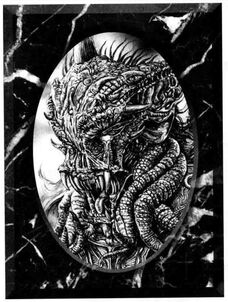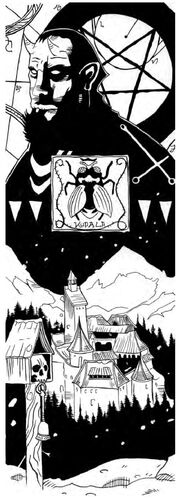
Servants of the demon Kupala
Kupala is a demon (some say a Talon of the Wyrm, others say an Earthbound), that dwells beneath Transylvania.
Background information[]
Long ago sensing the intrusion of powerful forces into lands he considers his own, the demon has made it his business to learn everything he can about his rival for power, though he has yet to learn that rival's True Name. Kupala's own actions are limited to sending out his lesser minions and granting visions to a madman who was once a shaman. Through Octavio, the Malkavian prophet, Kupala disseminates knowledge of his rival's plans.
Unfortunately, while the visions he grants are true, they are limited in scope; then those visions roil through the fractured landscape of Octavio's mind before the Malkavian foretells the future. Octavio does not always understand (or even remember) what he sees. This means that signs and portents he speaks of may actually illuminate something quite different than what either he (or those who listen to him) believe. Nonetheless, they remain one of the few ways a coterie can learn of the convoluted machinations occurring around them, hidden just beneath the surface of Cainite society.
Kupala's chosen prophet Octavio thinks that the visions he sees portend the rising of the demon and that entity's claiming of Transylvania and the lands of Eastern Europe. The prophet has not quite grasped, yet, that the things he foresees are related to a far larger picture – Gehenna. Eventually, Octavio will pass on his gift to Anatole through diablerie. The French vampire will understand the meaning of the visions, making him the Harbinger of Gehenna.
Though not much in evidence during this time, Kupala is still around and still working his chaos on the area. Evidence of the demon's continuing influence can be found in the Anarch-Assamite war in Transylvania – a war that makes no sense on the surface of things. The elder Tzimisce still celebrate Kupala's Night, but they do so more circumspectly now that their clan's founder was attacked on that eve. Octavio himself has fallen into torpor, temporarily leaving Anatole as the only one available to interpret the signs revealed by the demon. Despite the loss of his chief prophet and the maneuverings of the demon's as-yet unnamed rival, Kupala is far from gone.
In 1498, a coven of occultists assembled what fragments they could find concerning the maleficent demon Kupala. The result was a voluminous handwritten manuscript called the Incunabulum Kupalam. Although there are only a few copies, the tome became legendary within the occult history of mankind. In fact, by 1500, when many mortals begin to question the very existence of demons, Kupala is just getting started.
Relationship with the Tzimisce[]
Legends of the Tzimisce clan recall that the Eldest met Kupala long ago, when it first arrived at Transylvania. It was a slumbering entity, sealed by the Lupines and yearned for freedom. Despite great resistance, Tzimisce managed to free Kupala in exchange for mystic knowledge, but even the Antediluvian could not sever the ties between it and the Carpathian land.
Kupala's presence in the Carpathian soil may have influenced the nature of the Tzimisce clan weakness; the demon is also referenced by name, if not directly invoked, by some kolduns through a number of powerful Koldunic Sorcery rituals. Kupala, in the guise of "Root of All", influenced the founder Tremere and his conspirators in House Tremere to found the chantry of Ceoris and, later, to transform themselves into vampires.
The demon created a Sacred Fire-Flower, which is said to bind or loose demons and also might have been the fundamental stone to the ritual of Vaulderie, practised by the Sabbat. It also may have manipulated the Cathedral of Flesh to consume its master, the methuselah Yorak.
Kupala's Demesne[]

Of the handful of demons bound into the earth itself, Kupala is the oldest and most powerful. In fact, Kupala was the first demon ever to be bound in such a fashion, and he may even have invented the technique with the aid of his priests and followers. No matter how the binding occurred, it allowed Kupala to anchor his essence into the soil of the Carpathian mountains, deep in the heart of what would become Transylvania. Kupala inhabits not just a single mountain, but the entire range; his essence lies within every handful of soil in the coffins of those Tzimisce who worship him.
The demon lord's "body" is so large that even he cannot keep track of everything within his boundaries. He can certainly sense large or significant events, and bring his powers to bear upon them, but individuals often escape his attention. Even other demons can, upon occasion, pass through his border without being destroyed. Those demons and thralls who have survived such passage tell of a wilderness of brooding evil and darkness, where the constant presence of demonic power throbs in the soil like the beat of a giant and tainted heart. Within the region, power comes easily, and the energies of the demonic soul are always at hand — but that soul rages and snarls, barely controllable, lusting for destruction like a separate entity.
If mortals possessing demonic powers (i.e. thralls or demons with human hosts) enter Kupala's boundaries, they are tormented by the earthbound demon, making it harder for the mortals to control and withstand the horrors of their powers. However, through keen perception the mortals can detect the presence of taint in the very land they travel through. A subsequent investigation allows a character to realize just what those energies are, and what kind of place — what kind of being — they have entered. Hopefully they can escape before gaining Kupala's attention; the elder demon has no love for any of his kind, and his worshippers are hungry for the taste of demonic blood.
Time of Judgement[]
In the Final Nights, Kupala was used as a proxy between the Toreador and Nosferatu Antediluvians, and was ultimately freed from the land by an enterprising coterie in order to thwart the ancients' plans.
Trivia[]
In Slavonic neo-paganism, Kupala is the goddess of herbs, sorcery, sex, and Midsummer. She is also the Water Mother, associated with trees, herbs, and flowers. Her twin sister is Kostroma. Her celebration falls upon the Summer Solstice in June, which is a sacred holy day honoring the two most important elements of Fire and Water.
References[]
- VTM: Clanbook: Tzimisce, p. 18-19
- VTDA: Devil's Due, p. 38
- VTDA: Transylvania by Night
- VTDA: Transylvania Chronicles
- VTM: Clanbook: Tzimisce Revised
- VTM: Gehenna
